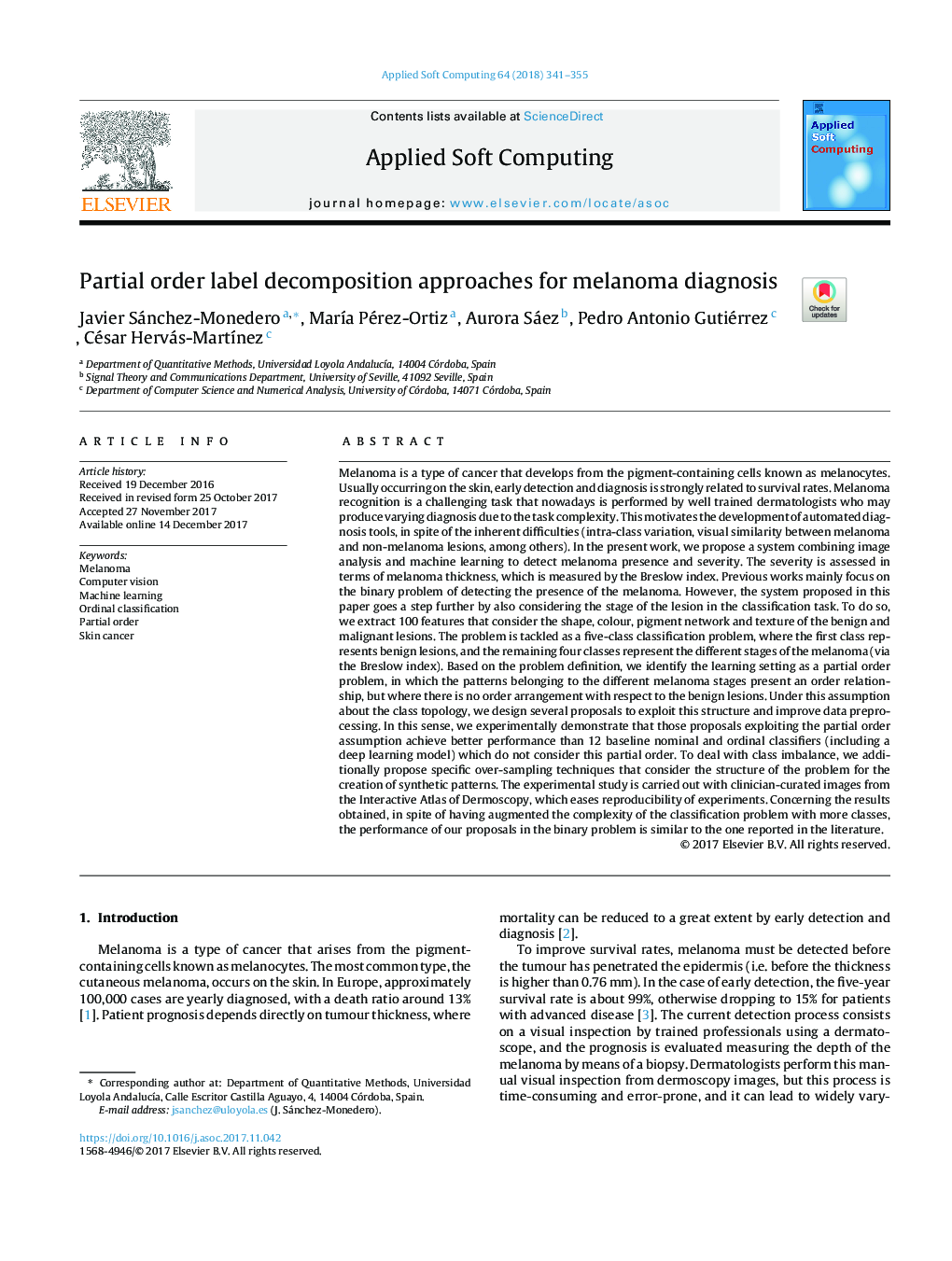| کد مقاله | کد نشریه | سال انتشار | مقاله انگلیسی | نسخه تمام متن |
|---|---|---|---|---|
| 6904119 | 1446996 | 2018 | 15 صفحه PDF | دانلود رایگان |
عنوان انگلیسی مقاله ISI
Partial order label decomposition approaches for melanoma diagnosis
ترجمه فارسی عنوان
روش تقسیم برچسب تقسیم بندی جزئی برای تشخیص ملانوم
دانلود مقاله + سفارش ترجمه
دانلود مقاله ISI انگلیسی
رایگان برای ایرانیان
کلمات کلیدی
ملانوما، دیدگاه کامپیوتر، فراگیری ماشین، طبقه بندی عمومی، نظم جزئی، سرطان پوست،
ترجمه چکیده
ملانوما نوعی سرطان است که از سلول های حاوی رنگدانه به نام ملانوسیت ها تولید می شود. معمولا بر روی پوست، تشخیص و تشخیص اولیه به شدت به میزان بقا بستگی دارد. تشخیص ملانوم یک کار چالش برانگیز است که امروزه توسط متخصصین پوستی به خوبی آموزش داده شده است که ممکن است به علت پیچیدگی وظیفه تشخیص داده شوند. این موضوع، به رغم مشکلات ذاتی (تنوع درون کلاس، شباهت بینایی بین ملانوما و ضایعات غیر ملانوم، و غیره)، باعث ایجاد ابزار تشخیص خودکار می شود. در این مقاله، ما یک سیستم ترکیب تجزیه و تحلیل تصویر و یادگیری ماشین برای تشخیص حضور و شدت ملانوم پیشنهاد می کنیم. شدت آن از لحاظ ضخامت ملانوم، که با شاخص بررسلو اندازه گیری می شود، ارزیابی می شود. کارهای قبلی عمدتا بر روی مشکل دوتایی تشخیص حضور ملانوم تمرکز دارد. با این حال، سیستم پیشنهاد شده در این مقاله گام به گام بیشتر نیز با توجه به مرحله ضایعه در انجام وظیفه طبقه بندی می شود. برای انجام این کار، ما 100 ویژگی را استخراج می کنیم که شکل، رنگ، شبکه رنگدانه و بافت ضایعات خوش خیم و بدخیم را در نظر می گیرند. این مشکل به عنوان یک مسئله طبقه بندی پنج طبقه مطرح می شود که در آن کلاس اول نشان دهنده ضایعات خوش خیم است و چهار طبقه باقی مانده مراحل مختلف ملانوم را نشان می دهند (از طریق شاخص برسلو). بر اساس تعریف مشکل، محیط یادگیری را به عنوان یک نظم جزئی جزئی شناسایی می کنیم که در آن الگوهای مربوط به مراحل مختلف ملانوم، یک روابط مرتبه ای را نشان می دهند، اما جایی که هیچ ترتیبی در مورد ضایعات خوش خیم وجود ندارد. تحت این فرض در مورد توپولوژی کلاس، ما پیشنهادهای متعددی برای بهره برداری از این ساختار و پیش پردازش داده ها را طراحی می کنیم. به این معنا، ما به طور تجربی نشان می دهیم که این پیشنهاد ها با بهره گیری از نظم جزئی، عملکرد بهتر از 12 طبقه بندی اسمی و مقدماتی (از جمله یک مدل یادگیری عمیق) را فراهم می کنند که این نظم جزئی را در نظر نمی گیرند. برای مقابله با عدم تعادل کلاس، ما علاوه بر این، تکنیک های بیش از حد نمونه برداری را پیشنهاد می کنیم که ساختار مشکل را برای ایجاد الگوهای مصنوعی در نظر می گیرند. مطالعات تجربی با تصاویری که توسط پزشک انجام می شود از اطلس تعاملی درماتوسکوپی انجام می شود که باعث می شود تجویز آزمایش ها کاهش یابد. با توجه به نتایج به دست آمده، به رغم پیچیدگی مشکل طبقه بندی با کلاس های بیشتر، عملکرد پیشنهادات ما در مسئله دودویی مشابه آنچه در ادبیات گزارش شده است، است.
موضوعات مرتبط
مهندسی و علوم پایه
مهندسی کامپیوتر
نرم افزارهای علوم کامپیوتر
چکیده انگلیسی
Melanoma is a type of cancer that develops from the pigment-containing cells known as melanocytes. Usually occurring on the skin, early detection and diagnosis is strongly related to survival rates. Melanoma recognition is a challenging task that nowadays is performed by well trained dermatologists who may produce varying diagnosis due to the task complexity. This motivates the development of automated diagnosis tools, in spite of the inherent difficulties (intra-class variation, visual similarity between melanoma and non-melanoma lesions, among others). In the present work, we propose a system combining image analysis and machine learning to detect melanoma presence and severity. The severity is assessed in terms of melanoma thickness, which is measured by the Breslow index. Previous works mainly focus on the binary problem of detecting the presence of the melanoma. However, the system proposed in this paper goes a step further by also considering the stage of the lesion in the classification task. To do so, we extract 100 features that consider the shape, colour, pigment network and texture of the benign and malignant lesions. The problem is tackled as a five-class classification problem, where the first class represents benign lesions, and the remaining four classes represent the different stages of the melanoma (via the Breslow index). Based on the problem definition, we identify the learning setting as a partial order problem, in which the patterns belonging to the different melanoma stages present an order relationship, but where there is no order arrangement with respect to the benign lesions. Under this assumption about the class topology, we design several proposals to exploit this structure and improve data preprocessing. In this sense, we experimentally demonstrate that those proposals exploiting the partial order assumption achieve better performance than 12 baseline nominal and ordinal classifiers (including a deep learning model) which do not consider this partial order. To deal with class imbalance, we additionally propose specific over-sampling techniques that consider the structure of the problem for the creation of synthetic patterns. The experimental study is carried out with clinician-curated images from the Interactive Atlas of Dermoscopy, which eases reproducibility of experiments. Concerning the results obtained, in spite of having augmented the complexity of the classification problem with more classes, the performance of our proposals in the binary problem is similar to the one reported in the literature.
ناشر
Database: Elsevier - ScienceDirect (ساینس دایرکت)
Journal: Applied Soft Computing - Volume 64, March 2018, Pages 341-355
Journal: Applied Soft Computing - Volume 64, March 2018, Pages 341-355
نویسندگان
Javier Sánchez-Monedero, MarÃa Pérez-Ortiz, Aurora Sáez, Pedro Antonio Gutiérrez, César Hervás-MartÃnez,
